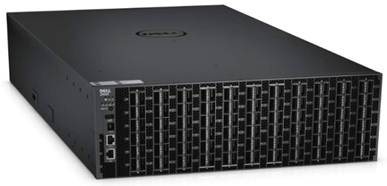Dell has made major strides in networking hardware over the last year, racking up an impressive number of awards and head turning products that are modernizing today’s data center, making good on our promise to disrupt the networking industry. Today Dell’s announcing a new addition to the networking hardware portfolio that is its most powerful networking switch to date – the Dell Networking Z9500 Fabric Switch. This switch introduces a number of firsts to the market for core, top of rack, middle of rack, and  end of rack switching that will continue to revolutionize the way customers are able to build out a high performance network.
end of rack switching that will continue to revolutionize the way customers are able to build out a high performance network.
Some of the key features of this switch that make it a leader in the industry:
The highest density switch per RU in the market today, period. High density is a critical factor in the modern data center. As data centers grow, floor space is at a premium and large chassis based networking architectures are a leading culprit in taking up precious space. Many of these chassis can take up to as many as 21 rack units (RUs) of space – about half the size of an entire rack. More RUs also usually mean more power consumption, additional management requirements, and much less space in the rack for other important data center components. All this adds up to higher capital expenses for businesses and continued operating expenses down the road. The Z9500 packs 132 40GbE ports or 528 10GbE ports with breakout cables into just 3 rack units!! I’ll say it again – just 3 rack units!! This is 6 times the density of the leading Cisco core switch – the widely deployed Cisco Nexus 7010. With industry analysts often saying data centers should build with plans to expand from 5-10 years into the future, a 3 RU core switch like the Z9500 is the leader today in giving customers the space they need to grow out their data centers for many years to come.
A leader in high energy efficiency. Higher density often also means more power is required to the entire rack, raising power requirements across the datacenter. The Z9500 is one of the leaders in energy efficiency, using only 4.1 watts of power per 10GbE port. To put this in perspective – the popular Cisco Nexus 7010 uses 15.9 watts for every 10GbE port in their chassis. 15.9 watts – that’s 3 times the amount of power consumption of the Z9500. Low power consumption again means efficiency in the rack – critical to the modern data center.
High bandwidth/low latency. These days with multimedia, video conferencing, IP telephony, and ever larger data file transfers, high bandwidth and low latency (i.e. less time waiting around) are critical. The Z9500 is our highest bandwidth switch to date – coming in at over 10 terabits per second. This is 4 times the bandwidth of our previous generation Z95000. It’s also a leader in the industry in terms of low latency – providing as low as 600 nanoseconds at full line rate – 40% lower latency than the Cisco 9508 – Cisco’s newest chassis. This box again easily supports customer’s “need for speed” across their entire IT infrastructure.
Customer centric scalability. The Z9500 uses an innovative “pay-as-you-grow” pricing model where customers are able to license either 36, 84, or 132 port skus according to their business needs. So far customers I’ve talked to really like this feature. When some customers see how big this box is they know that they will need this many ports someday soon but may not necessarily need so many ports today. At the same time they’re looking for solutions that will enable them to scale without having to “rip-and-replace” their current investments for bigger needs in the future. With “pay-as-you-grow pricing,” smaller data center customers can license as few as 36 ports for their current needs, and scale higher to match their business needs in the future. They are able to get all this while enjoying the benefits of high bandwidth, and low latency from such a powerful switch. For customers who need all 132 ports today – such as cloud providers – this box can easily support them today as well.
As you can see – we’re pretty excited about this box and expect it to be a disruptor in core switching well into the future. To learn more visit www.dellnetworking.com and continue to share your thoughts with us by following @DellNetworking and @DellEnterprise.